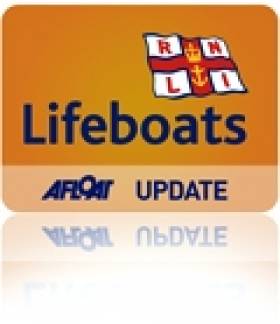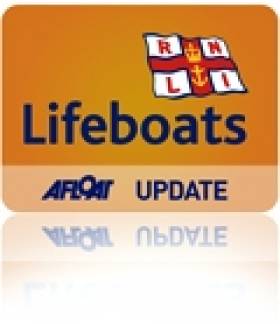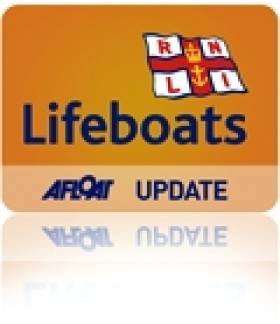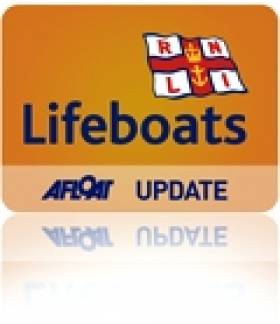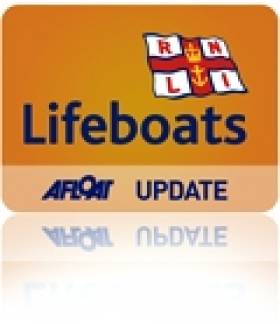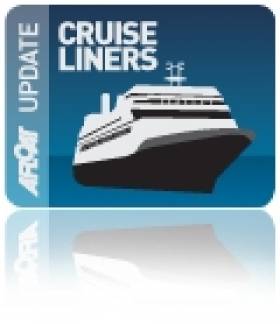Displaying items by tag: Lifeboats
Lifeboats Chief Visits Donaghadee, New Lifeboat for Arklow
#RNLI - Donaghadee lifeboat station was delighted yesterday (7 March) to welcome RNLI chief executive Paul Boissier, who was on a two-day visit to the Northern Ireland division.
Operational and fund raising volunteers crowded into the station to meet Boissier, who thanked them for coming out so early on a cold and wet morning.
While sitting enjoying the hospitality of the station, Boissier listened to the views of both crew and fundraisers on a wide range of topics. He said he was delighted to be in such a beautiful part of Northern Ireland and could not help but be impressed with the enthusiasm of all the volunteers.
He praised and thanked them for their commitment to the RNLI while remembering the support from the local community, and went on to say that the commitment of the operational volunteers supported by all at the station made the sea around the local coastline that much safer for everyone.
Meanwhile, Arklow RNLI was delighted to welcome the charity's newest lifeboat Kiwi and her volunteer crew to Arklow Harbour on Monday evening.
Prior to arriving in Arklow, the Tamar class lifeboat – which features the latest in search and rescue technology – had visited Torbay, St Mary’s on the Scilly Isles, Falmouth and Rosslare on her passage home to Wales. The weary crew arrived in Arklow after more than eight hours at sea.
The new vessel is a replacement station boat for Moelfre and replaces a Tyne class lifeboat similar to the one stationed at Arklow's flank RNLI station in Wicklow.
Kiwi was funded from a bequest by Reginald James Clark, a New Zealander who had been rescued by an RNLI lifeboat during World War II.
The crew from Moelfre was welcomed by Arklow RNLI's crew, fundraisers and station management along with members of the public.
Following her overnight stay in Arklow, she departed at 8.30am on Tuesday morning for her new home at Moelfre.
Arklow RNLI Aids Fishing Vessel Off Courtown
#RNLI - Arklow RNLI came to the assistance of three fishermen whose vessel got into difficulty off the Wexford coast yesterday (6 March).
The volunteer lifeboat crew was alerted shortly before 1.30pm following a report that a fishing vessel was adrift four miles east of Courtown Harbour.
The all-weather lifeboat, the Ger Tigchleaar, was launched within minutes and proceeded to the scene where the vessel, the MFV Telstar, had lost steering power.
Having located the casualty, the crew members established a tow and began the journey back to Arklow. All three crew members who remained on board the MFV Telstar were returned safely ashore.
Speaking ashore, the vessel’s skipper James Russell, himself an Arklow RNLI volunteer crew member and experienced seaman, paid tribute to his fellow lifeboat crew members Eamon Kavanagh, Matt Heaney, Scottie Heaney, Michael Fitzgerald, Andy Loughlin and David Lee who came to his crew’s assistance.
"I thought we were well prepared for situations which might happen at sea but knowing the lifeboat is there when needed is a great help," he said. "When anyone gets in to difficulty they should have no hesitation in calling for help as I did today."
Man and Child Drowned Off West Cork
#News - TheJournal.ie is reporting news of the tragic drowning of a man and a young child off West Cork in the early hours of this morning (6 March).
The bodies of the man and the three-year-old girl were recovered by emergency teams after the Goleen unit of the Irish Coast Guard was tasked to the area following a missing person's report.
Coastguard volunteers found the child on the beach but attempts to resuscitate her were unsuccessful. The body of the man was later discovered in the shallows by the Baltimore RNLI lifeboat.
It's being suspected that the man and the young child entered the water.
TheJournal.ie has more on the story HERE.
Challengers Gear Up For RNLI Station to Station
#RNLI - Two men are in training to complete the first RNLI Station to Station challenge on Saturday 6 April travelling from Bundoran Lifeboat Station to Arranmore Island Lifeboat Station in 10 hours – by foot, bicycle and kayak.
Leaving Bundoran lifeboat station at 6am on Saturday 6 April, Niall Clancy and James McIntyre will take two different routes and two different means to complete their challenge.
Clancy is set to run the entire distance of 100km door to door, including using a treadmill on the final leg from Burtonport Ferry Port via ferry to Arranmore Island, while McIntyre will cycle to Barnesmore Gap, run across the Blue Stacks down to Glenties, cycle to Portnoo and then kayak the remainder of the journey to Arranmore Island.
Clancy, a HSE advance paramedic, has already completed three marathons including Belfast and Dublin and also a half Ironman triathlon in Galway. He decided to do the challenge following a conversation with the Arranmore lifeboat crew during a recent visit.
He said: "The RNLI is a fantastic charity and as it is voluntary I wanted to do my bit to help raise funds for both Bundoran and Arranmore so, with James, we’re aiming to do that on 6 April."
Initially the plan had been to run 36 miles but when the idea was put to him to run from Bundoran to Arranmore, which is a further marathon distance of 26 miles, Clancy thought it was a great idea.
"Running 100km is something different and definitely a challenge – I definitely believe we can do it."
Meanwhile, McIntyre is no stranger to such challenges having completed a Coast to Coast challenge for Parkinson's last year, again using the combination of mountain running, cycling and kayaking to traverse Northern Ireland and end up at Creevy Pier.
McIntyre is always looking for the next idea to top his last one and is always happy to do it for charity.
On the day the two boys and their entourages will have support from the Bundoran and Arranmore lifeboat crews as well as runners, cyclists and members of the Tir Chonaill Athletic Club. Donations can be made in advance via the RNLI Station to Station website. The boys’ progress on the day can be followed on the Bundoran RNLI Facebook page, on Twitter @atlantic85 and also on the website.
Skerries RNLI Get New Lifeboat
#rnli – Skerries RNLI volunteer crew and station committee have this week received their new Atlantic 85 inshore lifeboat. The lifeboat was officially put on service last night (Thursday 28 February 2013). The north county Dublin lifeboat station is the beneficiary from a legacy that is three quarters of a century old. The new lifeboat is named in loving memory of Louis Simson, by his widow Charlotte, who passed away in Paddington in 1938.
The lifeboat arrived into the North Dublin coastal town on Monday 25 February from the Inshore Lifeboat Centre in Cowes on the Isle of Wright to start a week of trails and training with the Skerries RNLI volunteer lifeboat crew. During the handover and training the relief lifeboat Pride of Sherwood remained on service, ready to respond to any emergencies.
The lifeboat is named Louis Simson. Mr Simson was born in 1844 in London and ran a large sharebroking firm, with his bother Augustus, in Tasmania. Louis died on the 28 July 1922 aged 78 and was survived by his wife Charlotte. Mrs Simson wanted a lifeboat named in Louis's memory and this has now been made possible 75 years later. They have no surviving friends or family.
The new lifeboat has some advancements on its predecessor at the station. The Atlantic 85 design allows room for four crew members and more kit than the Atlantic 75 lifeboat, which only had room for three crew.
The lifeboat is powered by two 115horse power engines and has a stronger hull and greater top speed of 35 knots. The added radar allows the crew to operate more effectively in poor visibility and there is also VHF direction-finding equipment.
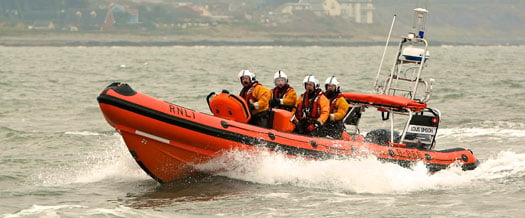
The Louis Simson. Photo: Eric Walsh
The vessel also has a manually operated self-righting mechanism which combined with inversion-proofed engines keep the lifeboat operational even after capsize. The lifeboat can also be beached in an emergency without causing damage to its engines or steering gear.
The Atlantic 85 carries a full suite of communication and electronic navigation aids, as well as a searchlight, night-vision equipment and flares for night-time operations.
Commenting on the arrival of the new RNLI lifeboat to the town, Mary Courtney Skerries RNLI volunteer lifeboat press officer said: 'Everyone involved with Skerries RNLI is delighted with their new state of the art lifeboat and is looking forward to familiarising themselves with it over the coming weeks. All lifeboat crew have already undergone a familiarity briefing and are currently undergoing intensive training onboard the vessel.
The volunteers with Skerries RNLI would also like to acknowledge both Louis and Charlotte Simson and their generosity to the lifesaving charity. Each time the lifeboat launches, it will have been made possible by this couple who lived a century ago on the other side of the world. We are eternally grateful to them'.
Overseeing the transition is RNLI Divisional Operations Manager Owen Medland added: 'We've had a wonderful week in Skerries familiarising the volunteer crew with their new lifeboat. Skerries RNLI is a busy lifeboat station on the east coast and the crew have handled many challenging callouts. They deserve the very best in lifeboat technology and I wish them well with their new lifeboat'
Skerries RNLI Aids Stranded Powerboat
#RNLI - Skerries RNLI went to the assistance of two people whose powerboat got into difficulty off the Balbriggan coast in north Co Dublin yesterday.
Shortly after 6pm last night (Tuesday 19 February) the station’s volunteer lifeboat crew was requested to launch after the alarm was raised by gardaí that a 4-metre speed boat was in difficulty just off Hampton Cove in Balbriggan.
The boat, which was approximately three miles out from Skerries, had fouled its propeller.
Weather conditions at the time were described as cold and dusk was settling into dark.
The Skerries RNLI crew put to sea accompanied in the air by the Irish Coast Guard helicopter, which had been on exercise locally.
Arriving on scene, it became apparent that the two people on board had managed to paddle their boat safely to the shoreline. The Skerries lifeboat crew proceeded to tow the speedboat back safely to Balbriggan Harbour.
Skerries RNLI Crew Shadows Ambulance Teams in Unique Learning Experience
#RNLI - Skerries RNLI volunteer crew recently undertook an exercise the likes of which they had not done before - shadowing a local ambulance team to observe how they respond to emergencies.
Philip Ferguson, a Skerries RNLI crew member, is also an advanced first responder with the local Dublin fire brigade. He has been on many sea rescues and call outs, and though not all have resulted in an ambulance being called to the scene, there are always those incidents that do require their specialist services.
In this regard, Ferguson believed that for the local lifeboat crew to witness how the ambulance teams operate would provide invaluable experience to the crews.
He approached Skerries RNLI lifeboat operations manager Niall McGrotty and divisional operations manager Owen Medland with his idea to discuss the possibility of some of the local RNLI crew joining the ambulance teams on some of their shifts in an observational capacity. They would not be allowed to take part or assist the HSE crew at any point, they were there to look and learn.
Both agreed that it was an exercise worth pursuing, and an arrangement was then made with the local HSE ambulance base in Swords. Over a period of three weeks, all of the RNLI crew took either a day or a night shift with the HSE ambulance crews. As the ambulance teams were called out, the RNLI volunteer rode along in the ambulance, observing the HSE teams at work be it at roadside after car crashes or to the homes to which they were called.
They witnessed first-hand the long hours and the dedication put in by the HSE ambulance teams as they waited in A&E at hospitals and transported their patients with care. Each individual who went on the exercise said it was, without doubt, an enlightening experience.
They also witnessed the professionalism of the HSE ambulance crews in sometimes very difficult circumstances. They saw how the ambulance crews worked with each other, their partners, and how they did their utmost to provide care and attention to the patient as they reviewed the situation, analysed the needs of the patient and did what was necessary to stabilise and transport that individual to hospitals. Each of the RNLI crew who went on the training came back with renewed and utmost respect for the ambulance crews.
The RNLI volunteer crew has not yet had to put their latest training to the test in 2013. However, with the knowledge they gained on the observational placements, they have added to their skills.
Such was the success of this exercise between that it is hoped it can be repeated. Skerries RNLI would like to thank each of the HSE ambulance crews for allowing them to spend time with them and learn.
Portrush Lifeboat Rescues Stranded Kayaker
#RNLI - Portrush RNLI has rescued a kayaker who got into difficulty off the Co Antrim coast.
The volunteer lifeboat crew had an early call out on Sunday morning (17 February) to the kayaker who got into trouble on the water at West Bay.
There were strong southerly winds at time which caused a swell. The kayak capsized and was whipped by the prevailing wind into the harbour area, leaving the kayaker stranded and treading water.
A Portrush lifeboat crew member who witnessed the scene on the West Strand spotted the incident and promptly raised the alarm.
The inshore lifeboat crew - including Mark Mitchell as helm, Andy McClelland and Stevie Ritchie - launched within minutes and had the kayaker back at base within 20 minutes.
Portrush RNLI lifeboat operations manager Robin Cardwell said: "The kayaker was very fortunate as the winds were quite strong in the West Bay. Our volunteer crew launched quickly and was able to bring him back to shore safely."
Search for Missing Spanish Fisherman Off Southwest
#Coastguard - The Irish Coast Guard's Rescue 115 helicopter was tasked overnight to search for a missing Spanish fisherman who fell overboard from his fishing trawler off the southwest coast in the early hours of this morning.
98FM is reporting the latest news on this incident, saying that the man went into the sea some 25 miles off Mizen Head.
The alarm was raised around 4am and the coastguard station at Valentia is co-ordinating the search and rescue effort, with RNLI lifeboats from Baltimore and Castletownbere in West Cork assisting.
Five Die In Canary Island Cruise Ship Lifeboat Drill
#CruiseLiners - The Guardian reports that five crew members on a British-operated cruise liner in the Canary Islands have died after a lifeboat fell 17 metres from the side of the ship and overturned during an emergency drill.
The crew - believed to include Indonesians, a Filipino and a Ghanaian - are thought to have been on board the lifeboat as it was being lowered from the vessel at the time of the incident.
Lifeboat launch drills are notorious for accidents, according to seafarers' union Nautilus International, who added that "there's been research which suggests that more people are dying in lifeboat drills than are being saved by lifeboats."
The Canary Islands are a popular holiday destination for people from Ireland and all over Europe seeking some winter sunshine. Reports say 2,000 passengers were on the cruise ship at the time but none were involved in the emergency drill.
The Guardian has much more on the story HERE.


























